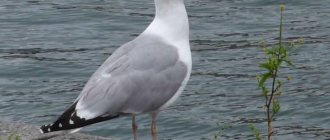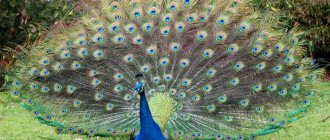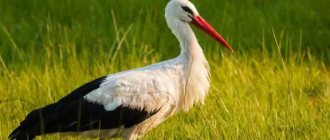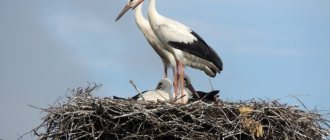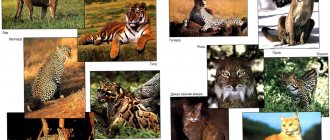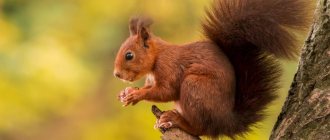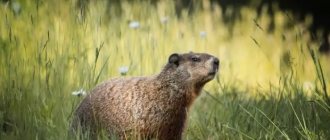The stork is a large bird, visually spectacular, and many fashion brands use this in their collections of clothing and accessories. But if you can often see these birds on dresses and handbags, in reality certain species of storks are even listed in the Red Book. The number of black storks (Ciconia nigra) is rapidly declining, and there are also few Far Eastern storks (Ciconia boyciana) left.
The stork family consists of 17 species and 9 genera; the birds are distinguished by a long graceful neck, large body, long unfeathered legs with a swimming membrane and a sharp beak. Different species of these birds differ from each other in appearance. What do storks eat, where do they live, how do they raise their offspring? What main species of these birds can you still meet? You will find answers to all these questions in the article.
White stork
Latin name: Ciconia ciconia. This species can be recognized by its snow-white plumage and black wing tips. Thanks to its contrasting color (the bird's legs and beak are bright red), the white stork has become a muse for many Asian artists; its image can often be found in Chinese and Japanese painting along with images of cranes. An adult bird weighs on average 4 kg, females - a little less. The wings of a white stork reach 60 centimeters in length. Attempts have been made to crossbreed a white stork with a black one, but nothing worked out because their mating rituals are too different. White storks are monogamous.
Black stork
Latin name: Ciconia nigra. Representatives of this species are slightly smaller than white storks: they weigh an average of 3 kg, and their wings do not exceed 55 centimeters in length. The color of the bird is usually not pure black, but with a greenish or red tint. The beak, limbs, throat and skin around the eyes are colored red. The belly of the black stork, the photo of which is presented below, is white. A characteristic feature of black storks is monogamy: they choose a partner for life.
Origin of the species
Based on ancient remains found in France, scientists have determined that the first three species of storks appeared at the end of the second geological epoch of the Paleogene period (in the Eocene).
In the Oligocene, which replaced the Eocene, the True Stork family reached its peak of diversity. Another 7 modern species separated in the later era of the Quaternary period.
According to ornithologists, white storks began to inhabit the area between the Black and Baltic Seas in the 15th century. In Western European countries, the bird was recognized during Roman colonization.
Brazilian Yabiru
Latin name: Jabiru mycteria. This is a large bird with a wingspan of up to 2.5 meters. The tip of the stork's long beak has a slight upward bend. The body of the Brazilian yabiru is white, and the head, neck and beak are blue-black. Females differ from males in having yellow eyes. The neck of the stork, the photo of which you can see below, has a red-orange tint at the base.
Marabou
The Latin name is Leptoptilos. This is the common name of the genus and includes Javanese, African, and Indian marabou. Like the Brazilian jabiru, these storks are large, with a large head and a massive beak. Even adult birds look more like ugly ducklings than beautiful swans. The wings reach 70 centimeters in length, and the birds weigh about 5 kg. The marabou has an unofficial name - “adjutant”, received for its gait, like that of the military. There is no feathering on the bird's head, as well as on the peculiar protrusion of the neck, which helps to hold the heavy beak. The tail, back and wings are dark gray or black.
Herbivorous birds
According to the method of feeding, all birds are divided into several groups:
- herbivores;
- insectivores;
- predatory;
- aquatic (feeds on fish).
Representatives of the herbivorous fauna are numerous.
The diet includes:
- flower petals and their juice;
- tree sap;
- kidneys;
- stems and shoots of grass;
- young green branches;
- grain sprouts;
- leaves;
- seeds;
- fruit.
The greatest diversity of birds inhabits tropical forests: 85% of living birds. Only 15% live at other latitudes. The structure of the beak and tongue is designed in such a way that it is possible to feed optimally: pecking, drinking juice, picking leaves and grass.
In our latitudes there are sparrows, titmice, nightingales, woodpeckers, pigeons, crows, magpies, cranes, starlings, orioles, and bullfinches.
In steppe areas, herbivores contribute to the accelerated regrowth of grasses. Excrement replenishes the supply of beneficial bacteria in the soil, enriches its composition with microelements, and stimulates the growth of vegetation.
Far Eastern stork
Latin name: Ciconia boyciana. It is an endangered species; in Russia the number of these birds does not exceed three thousand. Birds, like black and white storks, are monogamous. Outwardly they resemble white storks, but are more massive, and their beak is painted black. It also has other names: Chinese, black-billed stork. The area of skin around the eyes of Far Eastern storks is colored red. The extermination of individuals of this species entails not only a fine, but also imprisonment.
Natural enemies
Due to the large size and high location of the nests, storks do not have many enemies. Most often, their numbers are declining due to climate change, landscape changes and human activity. A dangerous enemy in modern cities is power lines. In addition, it has been precisely proven that sometimes storks themselves clear their population of weak individuals.
Photo: proprikol.ru
Starling (50 photos): description of the bird, habitat and what it eats
Stork feeding
The main hunting tool of storks is their beak. What do storks eat? The basis of the diet is animal food: from small insects, mollusks, pests and amphibians to small mammals. The stork can often be seen eating snakes and frogs. The stork, the description of which is presented to your attention in the article, is capable of catching a small bird, mouse, hare or gopher. Storks are usually slow, but can also pursue particularly interesting prey. It is not uncommon for these birds to travel long (5-10 km) distances from the nesting site in order to obtain enough food for the chicks.
The stork swallows food whole and is able to bring large quantities to its children. The structure of these birds also allows them to carry water in their beaks. When hunting, the stork is easily able to disguise itself as the vegetation surrounding it, remains motionless or walks very slowly. These birds make almost no sounds, so they do not attract the attention of their prey. Sometimes a stork may choose the eggs of other birds for lunch.
We already know what storks eat. I wonder in what quantity? After all, the bird is huge, and as you already know, it can swallow food whole. For normal functioning, the body of an adult stork needs an average of 700 grams of food per day. Storks are excellent hunters; there are cases when they caught up to 50 mice in one hour.
Ready to take over the zoo, the commission at the district executive committee has been informed
At the Mogilev Zoo, which is located near the regional center in the village of Buinichi, they told us that they could take the stork into their home. The only problem is how to deliver the bird from Gorki. And, of course, it is necessary that the removal of birds from the wild be carried out in accordance with the law.
The Goretsky District Inspectorate of Natural Resources and Environmental Protection explained that the district executive committee has a special commission that deals with wild animals that pose a threat to life and health or are in distress. The commission was informed and they promised to resolve the situation with the bird.
Lifespan
How long do storks live? In ideal artificial conditions, birds can live for more than a quarter of a century. How long do storks live in natural conditions? A rare individual lives up to 15 years. Factors that hinder the long life of storks include environmental conditions, natural selection, diseases, lack of food, and harm caused by humans and predators. Sometimes representatives of this family themselves shorten the lifespan of their fellows by pecking at sick birds. It has been noticed that storks live longest where the energy is positive, where there are no people swearing nearby, where peace and tranquility reign.
Stork wintering areas
The stork is a migratory bird, except for South African birds, which live in one place without flying anywhere. They are looking for wintering places where there will be enough warmth and plenty of food. Old and young storks go to warmer regions for the winter separately. As a rule, this occurs between the end of August and October. The migration occurs during the daytime, the birds fly high, the directions for European and eastern storks are different.
Birds whose habitats are located west of the Elbe head towards the Iberian Peninsula, then move towards Africa through Gibraltar. As a result, the birds winter in western Africa, in the area between the Sahara Desert and the tropics. European storks and birds from the Iberian Peninsula, and from Morocco, Tunisia and Algeria spend the winter here.
Birds whose nesting sites are located east of the Elbe go for the winter to a long territory between Sudan and South Africa. They fly first to the Bosphorus, then cross the lands of Asia Minor and Palestine, flying over the Nile River before reaching their destination. Part of the flock may remain in South Arabia, some choose Ethiopia for wintering, while the rest continue their long journey, some reaching India.
The wintering places of storks also differ depending on the species: white ones survive the winter in Africa, Pakistan, India, Korea, and the Japanese Islands. Black - south of the Sahara, in the Ganges River basin, in the southeastern part of China.
Characteristics of herbivores
Representatives of the fauna that feed on plant foods are forced to drink a lot of water, so they choose a habitat near natural bodies of water. Herbivores are endowed with a complex stomach structure that digests vegetation. The teeth have a flat crown.
The muscles of mastication are powerful and help to grind tough foods. Herbivorous animals have excellent hearing and a good sense of smell, with the help of which they detect the presence of a predator in time.
Large representatives have strong legs with hooves that protect them when moving on hard and rocky terrain. With their help, they can fight off enemies.
About the chicks
Most often, there are more eggs in a clutch than chicks hatch: some eggs remain unfertilized. Incubation lasts from 30 to 46 days.
Baby storks have vision but are otherwise helpless for the first 70 days of life. The chicks are white and fluffy, after hatching they lie for about 10 days, and for the first 7 weeks they remain in the place of birth - the nest. Even after the chick has learned to fly, the parents help it in search of food for 2-3 weeks.
While the stork chicks are in the nest, their weight may exceed the weight of their parents, but gradually their food is limited. Storks throw sick, weak chicks out of the nest, leaving only those capable of fighting for life. Sexual maturity occurs at the age of three years, birds begin nesting later - at 6 years.
Simply taking it in means breaking the law.
– Is it possible to shelter this stork?
– Here we need to take into account the legal aspect. The stork is a wildlife object and, according to the law, is the property of the state. Therefore, if government agencies are not involved in the seizure and further fate of this bird, then this must be agreed upon with local authorities.
– That is, If a person takes this bird home, will he be breaking the law?
– Strictly speaking, for which you face a fine and compensation for damage. But in practice, no one has ever been punished for helping storks. The easiest way to avoid problems with the law is to at least register the call with the territorial committee of natural resources. After this, we can say that local authorities were notified of the situation, which can be referred to in the future.
Habitat
What determines the habitat of storks? The bird, in order to find food that suits it, often settles in swamps, damp meadows and ponds with stagnant water. The preferred climate for storks is tropical, temperate or hot. Marabou build nests in trees, black storks prefer forests, white storks prefer lowlands, and yabiru prefer marshy areas.
White storks live in Europe, North-West Africa, Asia Minor and Central Asia, the Amur and Primorye regions, and the Japanese Islands. Black storks live in the southern part of the Iberian Peninsula, in the south to the Persian Gulf, in the north to St. Petersburg and Tomsk. For the black stork, the preferred nesting places are those where there are old forests and impassable swamps. This bird does not like to be near people.
Stork nests
The nests of these birds take up a lot of space: their diameter reaches 2 meters and their weight is more than 200 kg. Most often, birds choose roofs of houses or trees, but there are also unexpected places where stork nests have been found, for example, a lamppost. Previously, when the roofs of human dwellings were often thatched, storks settled there. Currently, their nests can be found on water towers and haystacks.
Materials for building a nest: branches, twigs, straw, grass, rags, wool, paper. The nest can accommodate adult parents and up to 7 eggs. Often, storks settle in places where their relatives already have homes. As a rule, storks live in one nest for more than one year, build it very carefully, and repair it as necessary.
Lifestyle and behavioral characteristics
Some species of storks are considered migratory birds. They form monogamous families in which they choose a mate for life. After wintering, the birds return to their habitats, and their mating season begins. At this moment, couples separate from other members of the pack, with whom they travel to hot countries.
At the time of migration, one flock can consist of several thousand individuals. Returning from wintering occurs in March or early April. The males arrive first and begin to arrange the house.
Storks click their beaks
During the day, storks search for food. They search for food mainly in the water, remaining with open wings and lowered beak. As soon as the predator notices the prey, it rushes forward and grabs it with its beak. Hunting usually takes place alone.
Stork hunting
On land, storks can hunt mice, ferrets or gophers.
Social structure
Storks live in a flock, the connection in which is temporarily weakened during the mating season. They communicate with each other using sounds produced by clicking their beaks. To make a sound, birds throw their heads back and retract their tongues into their beaks. A loud click occurs, amplified by the oral cavity. Storks cannot make sounds that resemble those of other birds.
The exception is the Black Stork. This species is capable of producing a sigh-like sound.
With the help of their communication language, storks show sympathy for each other, enter into mating relationships, or warn of danger. Males continuously click their beaks throughout the mating season. A couple liking each other shows their feelings by knocking their beaks.
Pair of storks
Storks have rules of survival that are quite cruel by human standards. Sick and weak individuals are slaughtered by stronger ones. This is considered a necessary condition for the survival of the species and the creation of healthy offspring. In this way, storks prevent the development of the disease and prevent the birth of sick birds.
Stork's home
Stork nests are located on tall trees with widely spread branches. Birds can also build nests on poles or roofs. The dwelling is built from sticks, brushwood, clods of earth, turf, reeds and reeds. Also, scraps of fabric can be used as improvised material if the birds find them. The size of the nest reaches approximately 1 meter in diameter.
Pairs of storks usually use the same nest. Returning from wintering in hot countries, they improve its appearance, correct shortcomings and settle in this place again. It is much easier for them to “repair” an old nest than to build a new one.
An important condition when organizing construction is the presence of a reservoir next to the nest. This is explained by the need for a place in which birds could constantly obtain food for themselves.
The male does the construction. The whole job takes him about two weeks. The stork carries twigs and large branches to the site and connects them to each other. At the bottom of the nest there is grass or hay. If birds live close to people, this could be rags, paper or wool.
Storks nest
All types of storks build their nest in their own way. White storks do this quickly, in a hurry, which is why holes often appear in the “house”. As a result, every year the birds need to seriously repair the gaps that arise. Black storks, on the contrary, care about the condition of their home. They make the walls stronger using wet clods of earth or clay.
Interaction with people
Recommended by topic
Blackbirds Woodpecker Heron
Since ancient times, people have patronized storks, considering them special birds. This was due to the fact that storks brought invaluable help to the farm: they destroyed locusts and killed snakes. All this, in a sense, made them sacred in a number of European countries. However, proximity to storks sometimes turned out to be detrimental for people, since predators were not averse to feasting on eggs and chicks raised at home.
Storks have been neighbors to people for a long time. They can settle near villages and towns, and sometimes even build nests near small towns. The chances of such a neighborhood increase if the settlement is located next to rivers and other bodies of water. Birds love such places because of the abundance of food and the absence of dangerous enemies.
Sometimes storks settle on the roofs of houses
Cohabitation with humans has become so profitable for storks that they began to change their migration route and settle down for the winter near settlements. These birds are not afraid of people, but at the same time they try not to let them close to their home.
